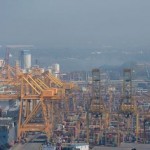On January 9, 2024, the United National Party (UNP) proposed incumbent Ranil Wickremesinghe as the national presidential candidate for the elections. This move may garner support from some political parties. In July 2022, six-time Prime Minister Wickremasinghe was chosen for his economic credentials by a parliamentary majority to replace Gotabaya Rajapaksa who resigned following mass protests over economic mismanagement and rent-seeking.
In April 2022, Sri Lanka became the first Asian country in the 21st century to pre-emptively default on debt, which amounted to over $50 billion. A devastating economic crisis followed. The GDP contracted by 7.8%, year on year inflation escalated to 69.8% in September 2022, the Sri Lankan rupee depreciated by 44.8% against the U.S. dollar, and usable foreign reserves fell to two weeks of imports creating shortages of medicine, food, and fuel.
Mr. Wickremesinghe’s government, with members of the Sri Lanka Podujana Peramuna (SLPP) led by Mahinda Rajapaksa, implemented an orthodox set of stabilisation policies. These included raising interest rates to control inflation, removing fuel subsidies, increasing taxes, passing a law to improve the independence of the Central Bank of Sri Lanka and initiating privatisation of state-owned enterprises. The government also sought Indian aid, intensified negotiations with the International Monetary Fund (IMF) on an Extended Fund Facility (EFF) and also foreign debt restructuring talks with private bondholders and bilateral creditors.
In March 2023, the IMF Board approved a EFF worth $2.9 billion over 48 months, emphasising fiscal and governance reforms. The first review by the IMF Board in December 2023 rated Sri Lanka’s performance as “satisfactory” meaning total IMF disbursement will be $670 million. The EFF unlocked additional funding from the World Bank and Asian Development Bank for budget support, social protection, financial sector development, and infrastructure development.
Progress is visible after 18 months of stabilisation policies. Inflation fell to 4% in December 2023 but could rise with the increase in Value Added Tax from 15% to 18% in January 2024. The Sri Lankan rupee appreciated by 12.1% against the U.S. dollar in 2023. Foreign exchange liquidity pressures eased. More import capacity means shortages of essentials and waiting lines have disappeared. The IMF projects a return to growth of 1.8% in 2024 compared with -3.6% in 2023.
Furthermore, foreign direct investment in infrastructure, due to Sri Lanka’s strategic location in the Indian Ocean, may also be picking up. A joint venture project between India’s Adani Group and Sri Lanka’s John Keells Holdings seeks to develop the $700 million West Container Terminal at Colombo Port. The U.S. Development Finance Corporation has committed $553 million. This will expand the capacity of the port and improve transhipment trade with a growing Indian economy.
In a geopolitical twist, China’s Sinopec Group, which will also manage 200 fuel filling stations in Sri Lanka, has committed $4.5 billion to an oil refinery in the controversial, low-profit Hambantota Port. Foreign exchange constraints and an inefficient state-owned Ceylon Petroleum Corporation led to fuel shortages and hardships for the Sri Lankans during the crisis. FDI by China’s Sinopec in petroleum refining and distribution may help improve Sri Lanka’s energy security provided the energy market is open to all investors and a strong competition policy is adopted. If not, Sri Lanka could be vulnerable to problems of a private monopoly under Sinopec with higher fuel prices and variable fuel supply.
Sri Lanka needs sustained economic growth of 5-6% in the medium term to escape from indebtedness. But its outlook is vulnerable to external and internal risks. The first is geopolitical competition between the U.S. and China. For instance, an intensified U.S.-China trade war following the possible victory of Donald Trump in the U.S. presidential elections could be devastating for inward FDI and trade in Sri Lanka.
The second is debt restructuring. In November 2023, Sri Lanka concluded an initial agreement with key bilateral creditors, including India and the Paris Club, to restructure $5.9 billion in external debt. This was important for reducing interest payments and unlocking IMF financing in 2024. This deal followed China’s separate debt restructuring agreement with Sri Lanka. These agreements are on similar terms, extending deadlines and lowering interest rates. But ominously, private bondholders, who held about 40% of external debt (end 2022), are concerned about the extent of the ‘haircut’ on debt they could face. They say there has been little engagement with them due to the focus on talks with official creditors.
Third, political risks could derail the EFF and growth beyond 2024 — presidential elections are due in September and general elections in 2025. A doubling of poverty to 25% of the population since the default, and growing dissatisfaction with the UNP and SLPP, appears to be leading to support for the left-wing populist National People’s Power. And Sajith Premadasa, the leader of the opposition, who is the head of the centre-right Samaji Jana Balwegaya, says he wants to renegotiate the IMF agreement.
Mr. Wickremasinghe deserves credit for pulling Sri Lanka back from the abyss. Only time will tell whether he can win the election.
Dr. Ganeshan Wignaraja is Professorial Fellow for Economics and Trade at Gateway House.
This article was first published by The Hindu.


